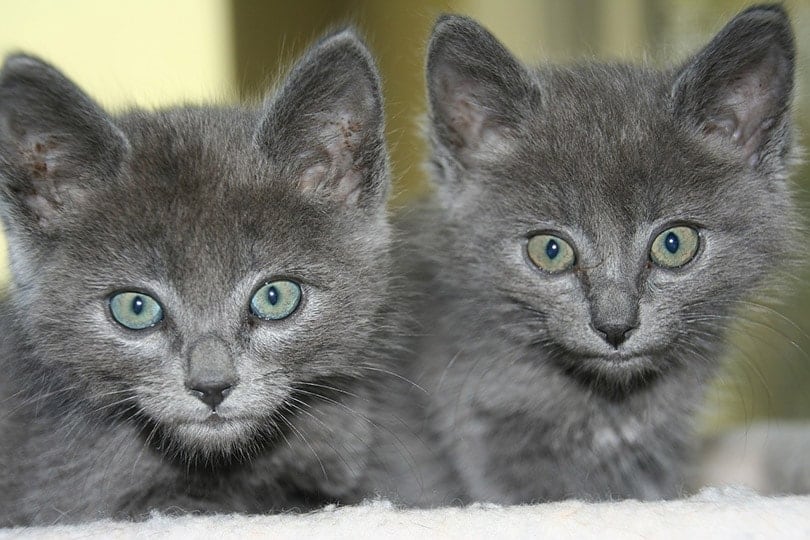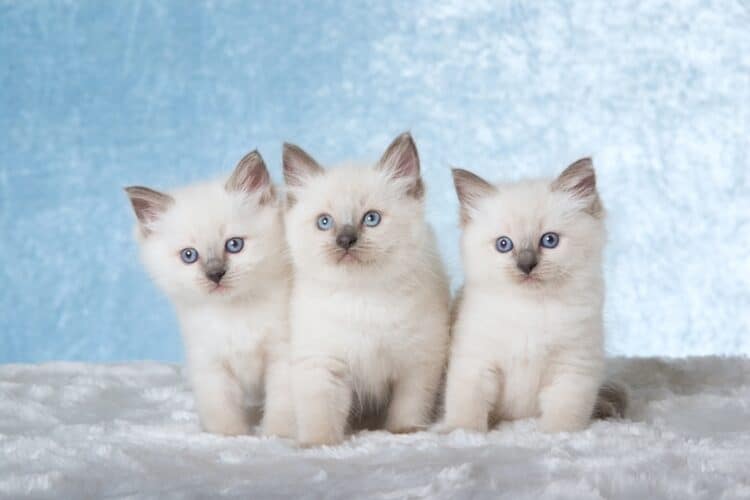Kittens’ eyes change color after they’re born. Almost all kittens are born with blue eyes, and their eyes gradually change color to the color they will be during their adult life. However, so long as the kitten’s eyes are not red, pink, or contain discharge, their eyes are healthy and should develop normally. Here’s everything you need to know about kittens’ eye development and what’s considered healthy.
At Birth
When a kitten is in the womb and shortly after birth, its eyes will be shut. Sealing the eyes closed in the womb and during delivery prevents foreign objects and substances from finding their way into the kitten’s eyes before birth.
2–16 Days Old
This is usually the period when a kitten’s eyes start to open. The exact time of the kitten’s eyes opening can vary widely, even between kittens from the same litter. Individual kitten’s eyes may open as many days apart from each other. Kittens depend on their sense of smell, touch, and their mother’s guidance to navigate the world at this stage, as their vision hasn’t fully developed yet.
3 Weeks Old
By this point, all the kittens in a litter should have their eyes opened. Their vision will continue to develop over the next few months. At this stage, most kittens will have blue eyes, but if the eyes are transparent, free of discharge, and not colored pink or red, the eyes are typical and do not represent a problem with the kitten’s health.
After this stage, the kittens’ eyes will change to the color that will persist throughout the cat’s adulthood. Some cats will retain their blue eyes into adulthood. Breeds such as the Tonkinese, Siamese, and Ragdoll are well known for their striking blue eyes.

Why Do Kittens’ Eyes Change Color?
The part of your eye that contains the color is called the iris. Two layers of the iris determine the color that appears, the stroma and the epithelium. The stroma’s pigment cells are loosely packed together, while the epithelium’s pigment cells are tightly packed together.
Both layers contribute different amounts to the overall color of the iris. A lot of pigment in the two layers of the iris will appear as gold or orange eyes. Less pigment will appear as green eyes, while no pigment in both layers will appear as blue eyes.
It is perfectly typical and healthy for a kitten’s eyes to change color, and it is equally familiar and beneficial for the eyes not to change color. As we’ve mentioned, several breeds are well-known for retaining their gorgeous blue eyes.
Still, most cats will experience a gradual shift in eye color as they age and mature. It can take up to a year before a cat’s eye color fully develops. Some cats may even experience an uneven eye color change, resulting in odd-eyed cats with heterochromatic or different-colored eyes.
Other than genetics, no factors influence your cat’s final eye color. Breed, coat color, sun exposure, food, and other woo-woo factors that might have been sold to you have no bearing on your cat’s adult eye color.
What Eye Colors Are Problematic?
The most notably difficult eye color changes a cat may experience occur in adulthood. Cats who experience a drastic eye color shift later in life may be late bloomers, but this is a sign of eye problems more often than not.
The eyes should also be evident regardless of the cat’s age. Cloudiness of the eyes, the coloration of the cornea (the transparent outer layer of the eye that you see through), or damage to the eye from play or an eye infection should be assessed by a veterinarian to ensure that the kitten’s overall health outcomes are on target.
Final Thoughts
It can be weird to imagine that it’s typical for a cat’s eye color to change, but it happens in humans sometimes too! As long as your cat eyes are of a specific color for cats, there’s no need to be concerned about an eye color change! Kittens are usually born with blue eyes, and some get to keep those piercing eyes into adulthood too!
Featured Image Credit: Shutterstock














